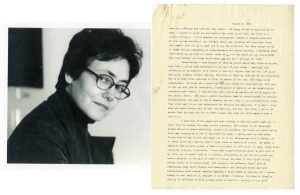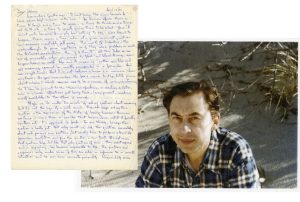Our guest blogger is Erika D’La Rotta, a graduate student in Library and Information Science (LIS) at the Catholic University of America, who completed her LIS practicum at Special Collections in the Fall 2023 Semester.

During the Fall semester, as part of my Archives Management coursework, I had the opportunity to participate in a 50 hour practicum with William John Shepherd, CUA’s Archivist and Head of Special Collections. My project was to arrange and process a small collection of letters, the Dolores Brien – Leo Dolenski Collection, which was generously donated to CUA in 2022 by Mary Ann Holthaus, a long-time friend. The collection contains weekly correspondence between Dolores Brien and Leo Dolenski from 1965-1974, in which they discuss their concerns about the Church, share ideas about their professions, and contemplate contemporary topics of interest.
Dolores was involved in the Grail, a Catholic Women’s Movement and spent time at Grailville, Ohio. Later in her professional career and for the majority of the letters, she was the Director of Career Planning at Bryn Mawr. Leo was a priest and taught Sociology. Their correspondence over ten years dealing with their concerns about the Church and contemporary issues led to their marriage. The collection also contains some newspaper clippings and magazine articles that the two attached to their letters throughout the years.

The opportunity to have hands-on work simultaneously with the classroom learning enhanced my educational experience. I have never worked within the Library and Information Science (LIS) field, but the classroom curriculum provided me with the foundational knowledge, network, and tools that I then applied the concepts on this project.
At the beginning, processing an archival collection seemed daunting! On my first day, I just stared at my box of unprocessed material wondering why I thought hands-on experience was a better option than writing a research paper; however, once I opened the box and looked through the letters to assess the collection, I knew I made the right decision. As I went through the entire collection, I made sure not to rearrange anything. It took me a while to come up with a plan for arranging and describing the collection. Once, I had a processing plan, I reviewed it with John to make sure I was on the right track.
I set out to arrange the collection in one series, arranging the correspondence chronologically by date in three month increments into acid-free folders to minimize the bulkiness of each file folder. The process of reorganizing the collection into 38 folders was a little tedious and extremely time consuming. My organization system included labeling each folder with the collection title, folder title, collection number, box number, and the folder number onto each folder. After labeling all the folders, I realized I had made a mistake with the folder numbers, which required me to start all over! Thank goodness for erasers. Erasing and renumbering took some time, but it was a lesson learned to slow down and always use a pencil. Additionally, I had to remove rusty paper clips from the letters, replacing them with new clips to limit the damage to the paper while preserving the order of the letters. My decision to replace the paper clips was to help keep the pages of the letters together. Fortunately, I managed to remove the old paper clips without tearing any of the letters!
After I arranged the collection, I moved on with developing a finding aid in ArchivesSpace to facilitate future research on this collection. Up to this point, CUA has never utilized ArchivesSpace for its collections, so I was excited to be a part of the Special Collections Department as they were transitioning from Encoded Archival Description (EAD) to ArchivesSpace!
My favorite part of the practicum was being around the Special Collections staff and LIS students. It gave me an opportunity to learn from more than one person and build professional relationships I would not have been able to otherwise.
Special thanks to Hannah Kaufman for scanning letters and photographs. For question about how to access this collection or any others, please visit our contact page.
